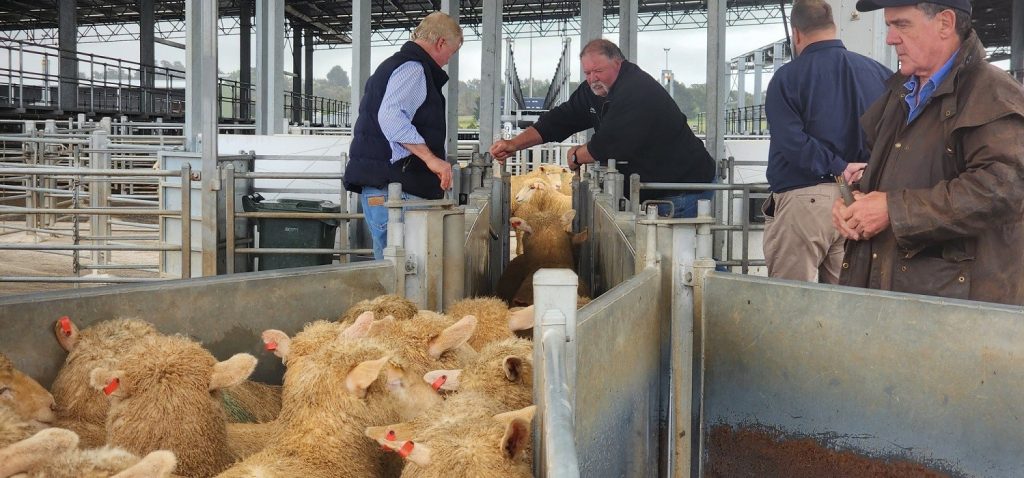
Lambs are drafted at the Ballarat saleyards during a NSW EID reference group visit. Source – Sally Martin, Twitter
IMPLEMENTATION of an electronic identification system for sheep and goats in New South Wales is technically and operationally feasible, according to NSW Department of Primary Industries group director livestock systems Dougal Gordon.
Mr Gordon chairs the NSW Sheep and Goat Traceability Reference Group that this week visited two saleyards – Horsham and Ballarat — and a lamb processor at Stawell in Victoria, where electronic identification for small stock is mandatory.
Mr Gordon told Sheep Central that his key take home message from the Victorian tour is that it is technically and operationally feasible to implement EID.
He said feedback from Victorian stock agents, saleyard operators and abattoirs showed they had managed to resolve implementation challenges. These included getting power to tag readers without interference, WiFi synchronisation of readers between drafting races, avoiding drop-outs by using WiFi and sim card connectivity from phones and tablets rather than Bluetooth.
In abattoirs, Mr Gordon, said insulation was used to minimise noise interference of readers in abattoirs and the extent of EID capability could be a commercial decision for each plant. He said processors could simply meet their legislative requirements to read tags before slaughter, but to support added brand traceability and sustainability claims, they could install post-slaughter readers and use hook tracking to enable tracing to the cut level.
Mr Gordon also noted that asking Victorian agents how they would achieve required EID and saleyard process outcomes had led to a number of technological developments such as the three-way Hamilton race reader.
Another key implementation learning for Mr Gordon was that for every state jurisdiction, education and training would be critical, including face-to-face workshops with supply chain segments, and especially for producers and stock agents.
He said agents that were initially opposed to EID in Victoria realised that once they understood the technology – the software and the hardware – “they actually made it work for them.” There were some delays with drafting, but office documentation was more efficient and accurate for post-sale summaries, National Vendor Declarations and updating the national Livestock Identification System database.
“It saved time at the end.
“Once they got on top of all the challenges they saw the benefits,” he said.
“They key message from them is that it is not as complicated as people make out, just get into it and get on with it.”
NSW sheep consultant and reference group member Sally Martin tweeted that implementation would be an industry team effort, according to sheep consultant Sally Martin.
Ms Martin tweeted that she had a great couple of days touring Victoria with the NSW reference group. The group is chaired by New South Wales Department of Primary Industries group director livestock systems Dougal Gordon.
The group is responsible for determining a proposed timeline for sheep and goat EID implementation in the state for the AGMIN meeting on 7 December, as well as other aspects of implementing the system, including engagement, education and training.
Ms Martin tweeted that the key take homes for her from the Victorian tour were: “It is not that complicated 2. The potential for Abattoir feedback looks great 3. Communication is still key 4. Traceability tech works 5. It will be a team effort. #eID”
In a webinar last month, Mr Gordon outlined the range of consultative activities the reference group would be undertaking, including a series of webinars for industry stakeholders.
The fourth reference group meeting was also held during the trip, communiques of which are available at www.dpi.nsw.gov.au/eid
The reference group has been considering a draft implementation timeline that proposed the statewide mandatory tagging of all sheep and farmed goats born on or after 1 January 2025 in the state. The draft timeline that would require all sheep and farmed goats in New South Wales to have electronic tags for off property movement by 1 January 2027.

HAVE YOUR SAY